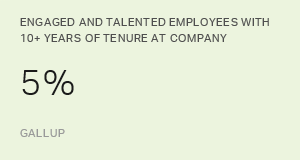Story Highlights
- More efficiency is needed to serve the "customers" of talent acquisition
- Data that could improve efficiency is often unused or improperly reviewed
- Maximizing efficiency requires support from leadership
If you've ordered a package from Amazon recently, you know how efficient that experience can be. With overnight delivery options readily available, it almost seems like you click "purchase" and the doorbell rings.
Retailers like Amazon have become obsessive about serving the customers in front of them.
By gathering and studying data as they work to maximize and improve their delivery processes, these retailers drive overall efficiencies to the delight of their customers.
Meanwhile, talent acquisition teams everywhere are wrestling with their own efficiency conundrum.
Talent Acquisition Data That Delivers
These teams are obsessively focused on filling requisitions. They are tasked with an incredible puzzle of making the experience evermore efficient for themselves, the hiring managers they serve, and the candidates, who are ultimately the customer of their employment brand experience.
As they seek to "delight" hiring managers and candidates alike, the best tackle this puzzle with the same gusto that online retailers have attacked overnight delivery.
CHROs and talent acquisition teams should take note and make use of the data that, in many cases, may sit unused or dormant and without proper review.
Here, in your existing talent acquisition data, you may find a goldmine of efficiencies.
Are you using your applicant tracking system (ATS) software to mine for the following types of information?
-
What candidate sources yield the most candidates and the highest quality candidates?
Digging in will likely yield insights into where your teams should spend more (or less) time or dollars in the future to maximize hiring results.
-
What requisitions, locations or job families enjoy a surplus or suffer from a shortage of talented candidates?
Identifying outliers will likely inform where you need to individualize your candidate attraction strategy. Ask yourself, which of these need to be revisited, updated or closed?
-
At what stage are candidates falling out of the process? What is the talent of these candidates that fall out of the pipeline?
Investigating where you are losing talented candidates will help you identify areas of your process that need to be tweaked or updated. A key question here: are you able to identify which candidates are talented?
-
Where are top candidates not offered roles? Is a reason captured?
If you are rigorous about capturing why your hiring managers are rejecting candidates -- particularly your high- quality candidates -- reviewing this data will help you to uncover potential blind spots in your process. This, in turn, helps uncover hiring manager training needs and highlight opportunities for internal alignment between talent acquisition teams and hiring managers.
-
Where are top candidates rejecting offerings? For what reasons?
If you are rigorous about capturing why your highest potential candidates are saying "no," reviewing this data will help. With it, you can identify if there are common reasons why you lose top candidates, so you have a clearer line of sight to barriers that need to be addressed.
-
What is the timeframe between identification of talent and when the offer is extended? How much variance exists in this timeframe? Does this timeframe correlate with offer rejections or candidate declines?
Digging in here will afford you clarity about whether you are delivering a consistent and timely experience for your candidates, and it will likely uncover opportunities to improve your process overall.
Investigating inefficiencies such as these in candidate pipelines can help you identify gaps or holes in the process where you may recoup talent. As gaps are noted and plugged, the aim is to increase the speed and quality of talent captured across the organization.
Improving the Efficiency of Your Hiring Process Requires Support From Leadership
CHROs, be ready to support your teams as they aim to improve their hiring ROI.
Here are some common barriers that you can help eliminate:
-
Ensure the talent acquisition team has the bandwidth to marshal the effort. We know time is at a premium in organizations and that, in general, managers report significant demands on theirs. Enable your teams to prioritize time to review key trends. Know that, in general, "managers report more stress and burnout, worse work-life balance, and worse physical wellbeing than individual contributors on the teams they lead." Given this, consider reallocating or reassigning ownership to ensure that your leaders have the time they need to review this data effectively.
-
Determine who has the skills to execute the effort. Great data analysts don't often end up working HR. Consider whether you have the data experts on board that you need to collect and understand your data. Even the best data won't give us insights without having humans to cull, wrangle and narrate it.
-
Make compliance a priority for trustworthy data. Unfortunately, using ATS systems is not easy. In order for you to have accurate data, you need to ensure end-user compliance. Consider your own culture -- what are the best incentives to ensure this happens? Again, do your teams have the time they need to prioritize this? If not, it may mean allocating some dedicated resources to ensure compliance occurs.
While large investments are made in ATS tools to optimize pipeline, as we all know, the tools alone are only as good as the people and leaders using them. Be ready to support your teams when they request the resources needed to tackle this effort.
Once you have thoroughly investigated your talent pipeline, you can begin to track who you hire, which will give you an idea about how your hires are panning out (so to speak). Tracking their performance can help you further maximize process efficiencies to yield results.
All in all, investing in a careful review of your candidate pipeline can yield opportunities to maximize the experience for your hiring managers and candidates by increasing the efficiency of the process. Ultimately, however, the greatest benefit may be the high-caliber hires your organization finds as a result.
Optimize your hiring process:
- Partner with Gallup to attract top talent.
- Design an exceptional employee experience.
- Equip managers with the tools to hire the right talent for the role.




